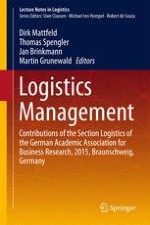2016 | Buch
Logistics Management
Contributions of the Section Logistics of the German Academic Association for Business Research, 2015, Braunschweig, Germany
herausgegeben von: Dirk Mattfeld, Thomas Spengler, Jan Brinkmann, Martin Grunewald
Verlag: Springer International Publishing
Buchreihe : Lecture Notes in Logistics
